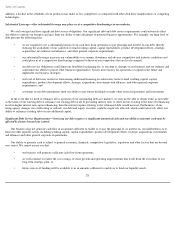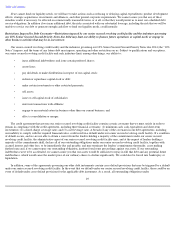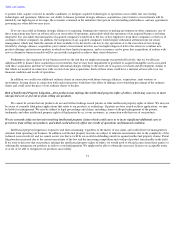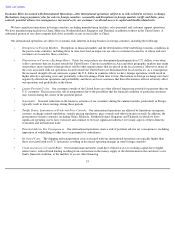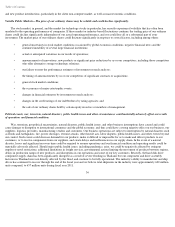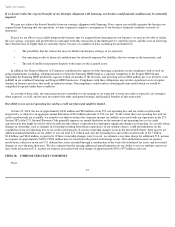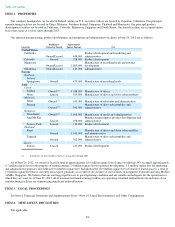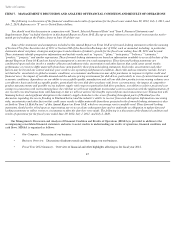Seagate 2011 Annual Report Download - page 40
Download and view the complete annual report
Please find page 40 of the 2011 Seagate annual report below. You can navigate through the pages in the report by either clicking on the pages listed below, or by using the keyword search tool below to find specific information within the annual report.
Table of Contents
If we do not realize the expected benefits of our Strategic Alignment with Samsung, our business and financial condition may be materially
impaired.
We may not achieve the desired benefits from our strategic alignment with Samsung. If we cannot successfully integrate the business we
acquired from Samsung into our operations, we may experience negative consequences to our business, financial condition or results of
operations.
Even if we are able to successfully integrate the business that we acquired from Samsung into our business, we may not be able to realize
the cost savings, synergies and growth that we anticipate from this transaction in the timeframe we currently expect, and the costs of achieving
these benefits may be higher than we currently expect, because of a number of risks, including but not limited to:
• The possibility that the transaction may not further our business strategy as we expected;
• Our operating results or financial condition may be adversely impacted by liabilities that we assume in the transaction; and
•
The risk of intellectual property disputes with respect to the acquired assets.
In addition, the Chinese Ministry of Commerce conditioned its approval of the Samsung acquisition on our compliance with several on-
going requirements, including: adopting measures to keep the Samsung HDD brand as a separate competitor to the Seagate HDD brand,
expanding the Samsung HDD production capacity within six months of the decision, and investing at least $800 million per year for three years
in R&D in our combined Samsung and Seagate HDD businesses. Compliance with these obligations may involve significant costs or require
changes in business practices that result in reduced revenue. Noncompliance could result in extending the time under which we would be
compelled to operate under these conditions.
As a result of these risks, the transaction may not contribute to our earnings as we expected, we may not achieve expected cost synergies
when expected, or at all, and we may not achieve the other anticipated strategic and financial benefits of this transaction.
Our ability to use our net operating loss and tax credit carryforwards might be limited.
At June 29, 2012, the use of approximately $346 million and $90 million of our U.S. net operating loss and tax credit carryforwards,
respectively, is subject to an aggregate annual limitation of $45 million pursuant to U.S. tax law. To the extent these net operating loss and tax
credit carryforwards are available, we intend to use them to reduce the corporate income tax liability associated with our operations in the U.S.
Section 382 of the U.S. Internal Revenue Code generally imposes an annual limitation on the amount of net operating loss or tax credit
carryforwards that might be used to offset taxable income when a corporation has undergone significant changes in ownership. As a result, future
changes in ownership, such as changes in ownership resulting from future repurchases of our ordinary shares, could put limitations on the
availability of our net operating loss or tax credit carryforwards. If certain ownership changes occur in the foreseeable future, there may be an
additional annual limitation on our ability to use our total U.S. federal and state net operating loss and credit carryforwards of $2.7 billion,
$1.8 billion, and $363 million, respectively. If these ownership changes were to occur, we estimate a one-time charge for additional U.S. income
tax expense of approximately $400 to $500 million may be recorded in the period such change occurs. This additional income tax expense
results from a decrease in our net U.S. deferred tax assets recorded through a combination of the write off of deferred tax assets and associated
changes to our valuation allowance. We also estimate that the ensuing additional annual limitation on our ability to use tax attribute carryovers
may result in increased U.S. income tax expense associated with such change of approximately $50 to $75 million each year.
ITEM 1B. UNRESOLVED STAFF COMMENTS
None.
37



